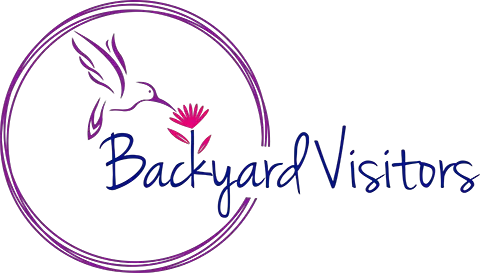This post contains affiliate links.
What types of hummingbirds are found in Ohio?
There are 8 species of hummingbirds found in Ohio:
- Allen’s Hummingbirds (Selasphorus sasin)
- Anna’s Hummingbirds (Calypte anna)
- Black-chinned Hummingbirds (Archilochus alexandri)
- Broad-tailed Hummingbirds (Selasphorus platycercus)
- Calliope Hummingbirds (Selasphorus calliope)
- Ruby-throated Hummingbirds (Archilochus colubris)
- Rufous Hummingbirds (Selasphorus rufus)
- Mexican Violetear (Colibri thalassinus)
Sighting Maps:
These 8 species of hummingbirds are documented as being seen in Ohio by sighting maps:
(click links to see sighting map)
- Allen’s Hummingbirds (Selasphorus sasin)
- Anna’s Hummingbirds (Calypte anna)
- Black-chinned Hummingbirds (Archilochus alexandri)
- Broad-tailed Hummingbirds (Selasphorus platycercus)
- Calliope Hummingbirds (Selasphorus calliope)
- Ruby-throated Hummingbirds (Archilochus colubris)
- Rufous Hummingbirds (Selasphorus rufus)
- Mexican Violetear (Colibri thalassinus)
These 8 hummingbird species found in Ohio are further categorized into 3 groups:
- Residents (Year-Round) Hummingbirds – these are hummingbirds that live full-time in Ohio and do not migrate.
- Seasonal Hummingbirds – these are migratory hummingbirds. Some are only passing through Ohio on their way north in the spring migration or south in the fall migration.
Some will remain and nest in Ohio all summer long but migrate south in the winter. A few seasonal hummingbirds may remain in Ohio for the entire winter by choice, injury, or old age. - Vagrant (Rare) Hummingbirds – these hummingbirds are out of their normal area of occupancy but have been documented as being seen in Ohio.
Ohio, known as the Buckeye State, is located in the heartland of the United States. There are no major mountain ranges, and 30% of the landmass is forested, making Ohio a hummingbird-friendly state during temperate conditions, but Ohio’s harsh winters prohibit most hummingbirds from remaining year-round.
Categories of Hummingbirds:
Year-round/Native Hummingbirds in Ohio:
This hummingbird classification is defined as hummingbirds residing in Ohio 365 days a year and do not migrate.
- There are no hummingbirds identified as Year-Round Residents but Ohioans may get a glimpse of a Rufous or Ruby-throated hummingbird mid-winter
Seasonal Hummingbirds In Ohio:
This hummingbird classification is defined as hummingbirds in Ohio temporarily as part of their migratory pattern. Some of each of these species spend the entire spring, summer, and fall in Ohio while others of this migratory group may travel to more northern states during the summer.
- Ruby-throated Hummingbirds
- Rufous Hummingbirds
Ruby-throated Hummingbirds
Ruby-throated hummingbirds have documented sightings in Ohio on the eBird.org sighting map.
Ruby-throated hummingbirds are the most common hummingbirds seen in Ohio.
Out of 10,000 hummingbird sightings in Ohio, about 9,800 will be Ruby-throated hummingbirds.
Rufous Hummingbirds
Rufous hummingbirds have documented sightings in Ohio on the eBird.org sighting map.
Rufous hummingbirds are the second most common hummingbird in Ohio but out of 10,000 hummingbird sightings, only about 91 of the sightings will be the Rufous hummingbird.
Rare/Vagrant Hummingbirds in Ohio:
This hummingbird classification is defined as hummingbirds residing in a group outside of their normal geographic range. Not only do these species of hummingbirds have a wide variety of specific geographic ranges, but they are also known to sometimes interbreed with each other creating hybrids.
- Allen’s Hummingbird
- Anna’s Hummingbird
- Black-chinned Hummingbird
- Broad-tailed Hummingbird
- Calliope Hummingbird
- Mexican Violetear Hummingbird
Allen’s Hummingbirds
Allen’s hummingbirds have documented sightings in Ohio on the eBird.org sighting map.
Out of 10,000 hummingbirds seen in Ohio, approximately 15 will be Allen’s.
See the sightings map on eBird.org for where in Ohio Allen’s hummingbirds have been seen.
Anna’s Hummingbirds
Anna’s hummingbirds have documented sightings in Ohio on the eBird.org sighting map.
You will have to be extremely lucky to see Anna’s hummingbird in Ohio, for every 10,000 hummingbirds seen, approximately 2 will be Anna’s.
See the sightings map on eBird.org for where in Ohio Allen’s hummingbirds have been seen.
Black-chinned Hummingbirds
Black-chinned hummingbirds have documented sightings in Ohio on the eBird.org sighting map.
Out of 10,000 hummingbirds seen in Ohio, approximately 11 of them will be Black-chinned hummingbirds.
See the sightings map on eBird.org for where in Ohio Black-chinned hummingbirds have been seen.
Broad-tailed Hummingbirds
Broad-tailed hummingbirds have 0 documented sightings in Ohio on the eBird.org sighting map, but one prominent website has the Broad-tailed hummingbird listed as an Ohio hummingbird.
See Broad-tailed hummingbird Ohio sighting map at eBird.org for up-to-date sighting information.
Calliope Hummingbirds
Calliope hummingbirds have documented sightings in Ohio on the eBird.org sighting map. Out of 10,000 hummingbirds seen in Ohio, approximately 18 will be Calliope hummingbirds.
See the sightings map on eBird.org for where in Ohio Calliope hummingbirds have been seen.
Mexican Violetear
The Mexican violetear hummingbird has documented sightings in Ohio on the eBird.org sighting map.
Out of 100,000 hummingbirds seen in Ohio, only 1 will likely be a Mexican Violetear hummingbird.
See the sightings map on eBird.org for where in Ohio the Mexican violetear hummingbird has been seen.
Read on to find out more about each of these hummingbird species.
Year-Round/Native Hummingbirds
There are no hummingbirds identified as year-round residents, however, Ohioans may get a glimpse of a Ruby-throated or Rufous hummingbird during the middle of winter.
Seasonal Hummingbirds
RUBY-THROATED HUMMINGBIRD – (Archilochus colubris)
Conservation Status: Least concerned
Kingdom: Animalia
Phylum: Chordata
Class: Aves
Order: Apodiformes
Family: Trochilidae
Genus: Archilochus
Species: A. colubris
Ruby-throated hummingbirds have documented sightings in Ohio on the eBird.org sighting map.
Ruby-throated hummingbirds are the most common hummingbirds seen in Ohio.
Out of 10,000 hummingbird sightings in Ohio, approximately 9,800 will be Ruby-throated hummingbirds.
See the sightings map on eBird.org for where in Ohio the Ruby-throated hummingbird has been seen.
According to the Ohio Department of Natural Resources, Ruby-throated hummingbirds are categorized as seasonal residents, even though they are the most commonly seen in Ohio.
The Ruby-throated hummingbird’s scientific name originated from Carl Linnaeus, a Swedish botanist, who first listed this scientific classification as “Trochilus colubris”. Its name changed over a hundred years later and was reclassified by Ludwig Reichenbach, a German botanist to “Archilochus colubris”, which is its current scientific name, meaning “top thief” or “sky spirit/sun-god bird”.
Male Ruby-throated hummingbirds have a striking iridescent blood-red gorget, stopping at the neckline. He is identified with a dull metallic green topside, a light gray underbelly, and black wings. The Ruby-throated hummingbird is a smaller species of hummingbirds weighing less than 4.5 grams or 2 U.S. dimes and is 2.8 to 3.3 inches in length. Their lifespan is approximately 3-5 years.

Photo by: Rekha Pawar
Taken: Ohio
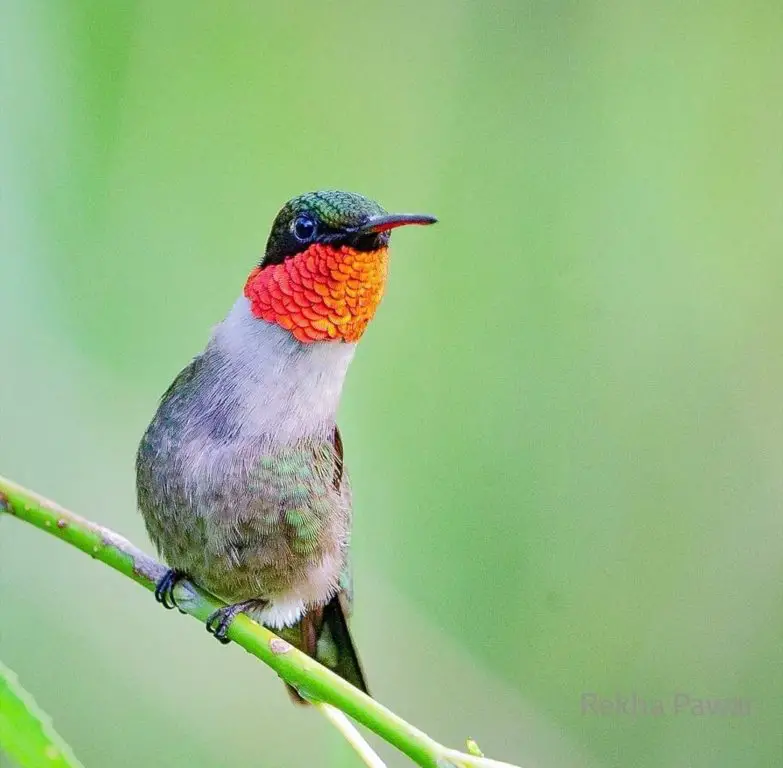
Photo by: Rekha Pawar
Taken: Ohio

Photo by: Rekha Pawar
Taken: Ohio
Female Ruby-throated hummingbirds have a white throat with some light stippling and are typically larger than the males. The oldest female Ruby-throated hummingbird has been recorded at 9 years, almost double that of the male.
However, the average lifespan of a Ruby-throated hummingbird is approximately 3-5 years.
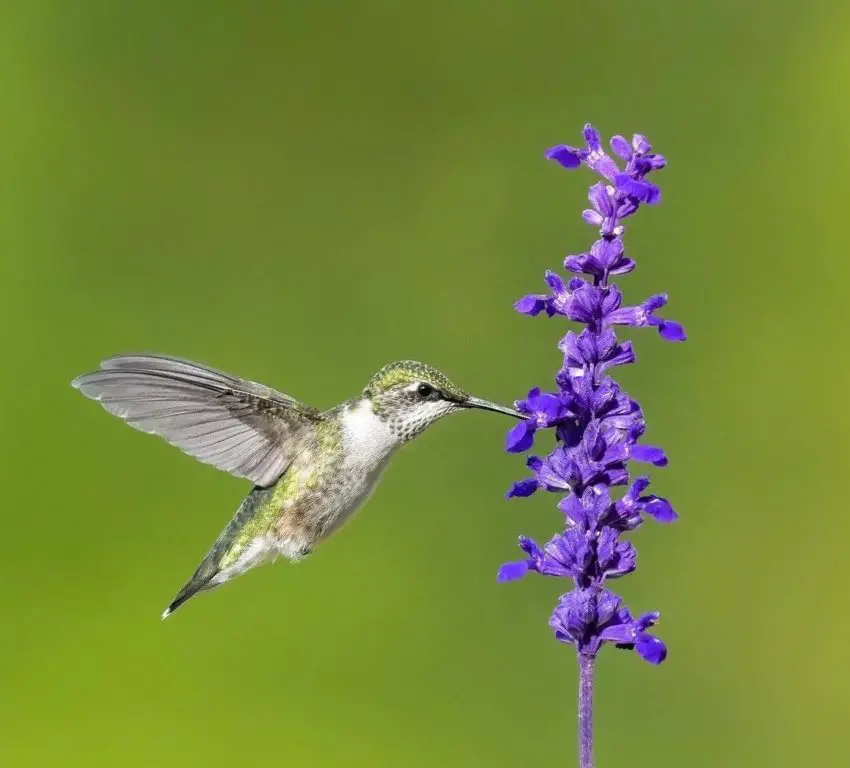
Photo by: andy_raupp
Note: The flower that this female Ruby-throated hummingbird is drinking from is called Salvia – ‘Rhea Blue’
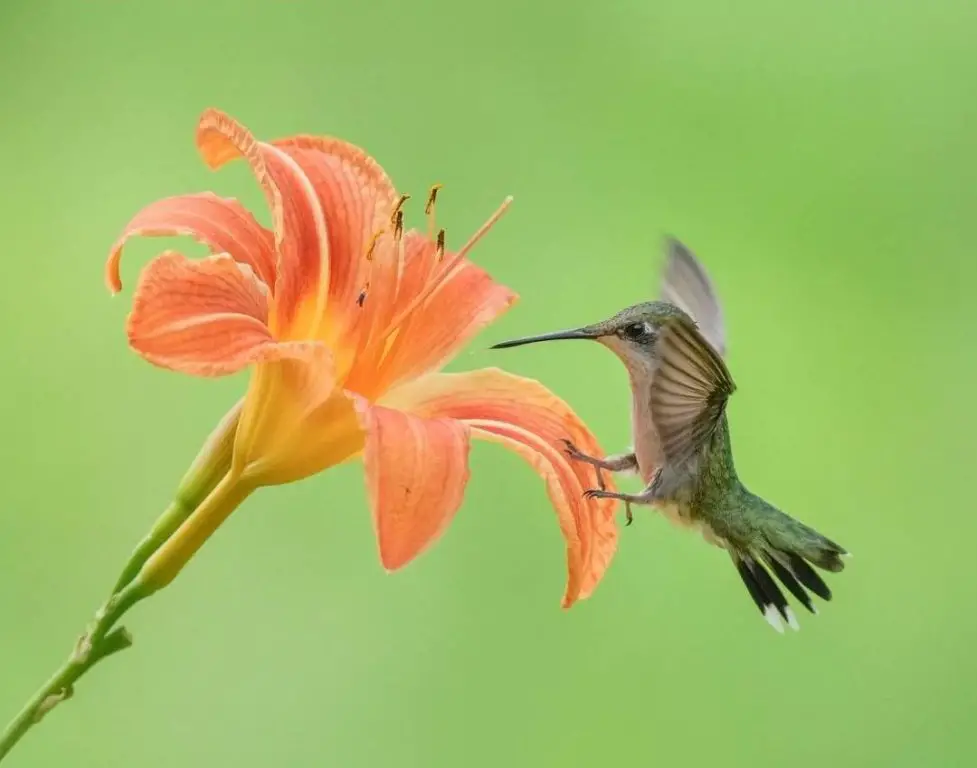
Photo by: andy_raupp
Juvenile male and female Ruby-throated hummingbirds during their initial stages of life resemble their mother exhibiting a white throat with light stippling.
As the males mature, they begin to display a few specks of color near their neckline and eventually their bolder red throat feathers become more dominant and stately displaying a colorful gorget.
Juvenile females show a light faint grey stippling on their throat. As both sexes mature their less vivid and lighter colored plumage will begin to mature and become darker in color.

Photo by: Rekha Pawar
Taken: Ohio
Note: His throat feathers are slowly coming in, displaying a few dots of color near his neckline and showing the first stages of adolescence.

Photo by: MaryLou Ziebarth
Note: This juvenile Ruby-throated hummingbird is struggling with a bee or wasp situation at the feeder.
See my article: Bees On My Hummingbird Feeder: (9 Tips To Get Rid of Them)
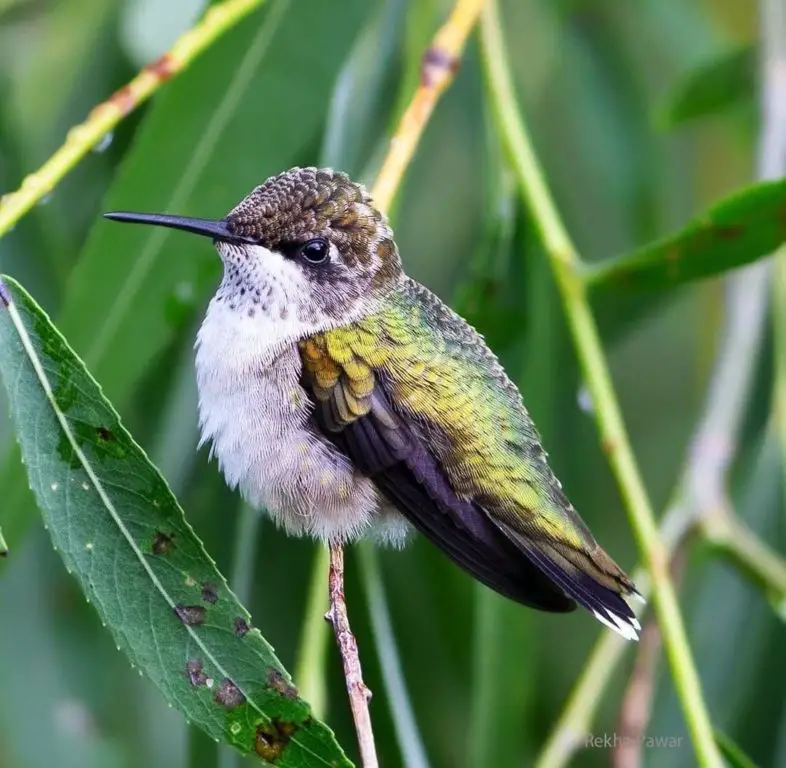
Photo by: Rekha Pawar
Taken: Mansfield, Ohio

Photo by: Rekha Pawar
Taken: Mansfield, Ohio
Note: The newly white fluffy down feathers on this baby/juvenile Ruby-throated hummingbird’s bottom. Also, notice the nice fat reserves they have accumulated by being fed by their diligent mother which will sustain them through adolescence.
There are two migration routes for the Ruby-throated hummingbird during the spring and fall migrations.
The first migration route is a direct but exhausting nonstop journey southwest over the Gulf of Mexico to Mexico and then down to Central America for the winter. The flight distance over the Gulf of Mexico is over 500 miles. Although this is the direct “short” route, there are numerous obstacles faced by these birds.
Some obstacles include not being able to rest, no means to refuel or eat and having to avoid the dangerous tropical Atlantic hurricanes while flying to their destination. To make matters worse, depending on how you look at it, they migrate during the dark hours of the night or are taking the “Red-eye flight”.
Researchers believe their small size makes the energy expenditure of their grueling trans-oceanic migration pattern more taxing for males than for females even though they both double their body’s fat prior to making the migration across the Gulf of Mexico.
The second migration route is over 2,000 miles, flying along the coastline outlining the Gulf of Mexico. Although this is the “long” route, it allows the opportunity to rest and refuel even though there are fewer food source guarantees along the way.
Scientists are unclear and continue to investigate why one group of birds would prefer to take one route over the other.
See my article: Hummingbird Migration in Ohio
Ruby-throated hummingbirds prefer open woodlands and are often seen in parks, gardens, and backyards. They are solitary birds except during mating periods when they are fiercely territorial and aggressive towards hummingbirds of other species.
Even though these hummingbirds have an aggressive side they can still be eaten by predators such as large invertebrates, praying mantises, orb-weaver spiders, and dragonflies.
See my article: 10 Common Things That Kill Hummingbirds
During a capture and release banding operation in West Virginia, the oldest living recorded female Ruby-throated hummingbird was 9 years and 1 month old.
See my article: 3 Reasons Why Hummingbirds Are Banded
See pictures of male, female, and juvenile Ruby-throated hummingbirds here…..
Hear sounds of Ruby-throated hummingbirds here…..
RUFOUS HUMMINGBIRD – (Selasphorus rufus)
Conservation Status: Near threatened
Kingdom: Animalia
Phylum: Chordata
Class: Aves
Order: Apodiformes
Family: Trochilidae
Genus: Selasphorus
Species: S. rufous
Rufous hummingbirds have documented sightings in Ohio on the eBird.org sighting map.
Rufous hummingbirds are the second most common hummingbird in Ohio but out of 10,000 hummingbird sightings, approximately 91 of the sightings will be the Rufous hummingbird.
See the sightings map on eBird.org for where in Ohio the Rufous hummingbird has been seen.
The Rufous hummingbird gets its name from the Latin word rubrum meaning “red” which is used to describe its reddish-brown coloring.
Male Rufous hummingbirds display an iridescent orange-red gorget with rusty-colored flanks and tail. They have a white to beige underbelly and a black bill. Males can also have green plumage with specks of green color on their rustic-looking backs or on the crown of their head along with chocolate brown dorsal feathers. Their size is 2.8 inches to 3.5 inches in length and weighs 3.2 grams.

Photo by: Kevin Walsh
Note: The iridescent orange-red gorget.

Photo by: Kevin Walsh
Note: The gorget appears chocolate brown in this lighting, however, you can still see a glimmer of his iridescent orange-red gorget with some hints of yellow.

Photo by: jace_the_bird_nerd
Juvenile male Rufous hummingbirds have a rustic look with small iridescent orange specks of color on their throats.
Juvenile Rufous hummingbirds are so similar in coloring and temperament to Allen’s hummingbird that they are practically indistinguishable in the field. Therefore, identification is established by range rather than appearance.

Photo by: Rekha Pawar
Taken: Ohio
Note: His throat feathers are slowly coming in, displaying a few dots of color near his neckline and showing the first stages of adolescence.

Photo by: Rekha Pawar
Taken: Ohio

Photo by: Rekha Pawar
Taken: Ohio

Photo by: Rekha Pawar
Taken: Ohio
Note: Preening flight feathers is an important daily routine to maintain hygiene and to keep the feathers flexible, strong, in alignment, and parasite-free.
Female Rufous hummingbirds are green and white with some iridescent orange feathers on their throat. Their tail is dark with white tips and an orange-red base. Female Rufous hummingbirds are slightly larger than the males in anticipation of producing offspring.

Photo by: Kevin Walsh
They have one of the northernmost breeding ranges of any hummingbird in the world; migrating north from Mexico and nesting as far north as Alaska to breed during the summer months. They are polygamous and will mate with several partners in a season.
See my article: Hummingbird Parents: (Mating to Nesting)
See my article: Baby Hummingbirds: (Egg to Fledgling)
The females and juvenile Rufous hummingbirds in Ohio mostly migrate in September. Expect to see an increased volume of southern migrating hummingbird visitors to your feeders in Ohio during fall migration from August through October.
Rufous hummingbirds make the longest migrations of any bird in the world. They travel making a clockwise circuit of western America every year that is approximately 3,900 miles.
This migratory pattern during the seasons coordinates their arrival perfectly while catching nectar and blooming flowers throughout the year, fueling their bodies for their long journey.
Hummingbirds are much more tolerant of cold temperatures than most people realize.
According to eBird.org, through branding practices in Wisconsin, the Rufous and Ruby-throated hummingbirds have been documented surviving in temperatures of -9F and wind chills of -36F.
See my article: 3 Reasons Why Hummingbirds Are Banded
Some Ohioan hummingbird admirers leave hummingbird feeders up all winter long to provide life-nourishing nectar to the most commonly seen residents in Ohio, the Rufous and Ruby-throated hummingbirds.
This selfless act also provides nectar to other migrating species unable to migrate because of injury or old age.
See my article: 11 DIY Ways to Keep Hummingbird Nectar From Freezing
Rufous hummingbirds are highly territorial and aggressive towards other hummingbirds and animals. They are fearless and have a reputation for chasing away not only other hummingbirds but even large birds and rodents from their favorite feeders. They have been known to even attack squirrels and chipmunks that come too close to their nest.
Rufous hummingbirds have excellent memories and have been known to investigate the location of an old hummingbird feeder years after the feeder has been removed.
Their flying acrobatic skills can outmaneuver all other hummingbird species, making them extremely competitive at feeders.
Hummingbird enthusiasts are extremely valuable when they plant flowering plants to attract hummingbirds and provide feeders with homemade hummingbird nectar to contribute to successful migration. These welcoming habitats provide and ensure safe travels as well as a reliable sanctuary for rest and refueling during their journey.
During a capture and release banding operation in British Columbia, the oldest living recorded female Rufous hummingbird was 8 years and 11 months old.
See my article: 3 Reasons Why Hummingbirds Are Banded
Due to habitat loss in the Pacific Northwest, Rufous hummingbirds are listed at “near threatened” status by the IUCN red list of threatened species.
See pictures of male, female and juvenile Rufous hummingbirds here…..
Hear sounds of Rufous hummingbirds here…..
Rare/Vagrant Hummingbirds
This hummingbird classification is defined as hummingbirds residing in a group outside of their normal geographic range. Not only do these species of hummingbirds have a wide variety of specific geographic ranges, but they are also known to sometimes interbreed with each other creating hybrids.
ALLEN’S HUMMINGBIRD – (Selasphorus sasin)
Conservation Status: Least concerned
Kingdom: Animalia
Phylum: Chordata
Class: Aves
Order: Apodiformes
Family: Trochilidae
Genus: Selasphorus
Species: S. sasin
Allen’s hummingbirds are rare migratory visitors to Ohio because they commonly reside and nest along the California coast and winter in Mexico. However, some continue their migration and wander farther east into Wisconsin, south into Texas and continue their journey as far as Florida being noted as rare migrants.
Allen’s hummingbirds have documented sightings in Ohio on the eBird.org sighting map.
Out of 10,000 hummingbirds seen in Ohio, approximately 15 will be Allen’s.
See the sightings map on eBird.org for where in Ohio Allen’s hummingbirds have been seen.
The common name of Allen’s hummingbird is in commemoration of Charles Andrew Allen (1841-1930), an American collector and taxidermist.
Male Allen’s hummingbirds are green-backed with a green forehead and rust-colored flanks, rump, and tail. When their tail feathers are fanned out you can see their chocolate-colored tips. The gorget of the male Allen’s hummingbird is an iridescent orange-red, however, in darker lighting, it can appear chocolate brown. Allen’s hummingbirds are 3.3 inches to 3.5 inches in length and weigh 2-4 grams.
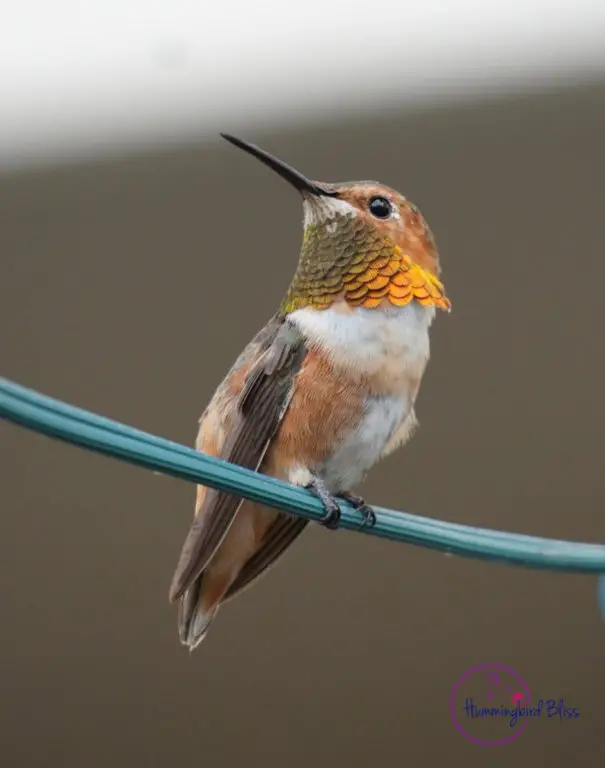
Note: The iridescent orange-red gorget.

Note: The gorget can appear chocolate brown in certain lighting. This is the same adult male Allen’s hummingbird featured above.
The females and juveniles have similar coloring as the males, but do not have an iridescent gorget.

Photo by: aarongomperts
See my article: Hummingbird Parents: (Mating to Nesting)
See my article: Baby Hummingbirds: (Egg to Fledgling)
Their nesting season is perfectly timed to when the regions have the most rainfall which helps provide prolific nectar producing flowers for their offspring.

Note: On a tomato cage defending a feeder. In this picture you can still see his newly white fluffy down feathers on this baby/juvenile hummingbird’s bottom. Also, notice the nice fat reserves they have accumulated by being fed by their diligent mother which will sustain them through adolescence.

Note: On a tomato cage and hiding in a tomato plant near a feeder.
Juvenile Allen’s hummingbirds are so similar in coloring and temperament to a Rufous hummingbird that they are practically indistinguishable in the field. Therefore, identification is established by range rather than appearance.
Male Allen’s hummingbirds perform a striking, quick back-and-forth courtship dance resembling the movement of a pendulum. They have one of the most complex territorial dive displays of any North American hummingbird.
See my article: Hummingbird Dance: 5 Interpretive Explanations…..
Male and female Allen’s hummingbirds are not social birds. They do not associate with one another outside of breeding. Similar to a Rufous hummingbird, Allen’s hummingbirds are highly territorial and aggressive towards other hummingbirds and larger predatory birds such as hawks.
During a capture and release banding operation in California, the oldest living recorded Allen’s hummingbird was 5 years and 11 months old when she was first captured in 2004 and again in 2009.
See my article: 3 Reasons Why Hummingbirds Are Banded
See pictures of male, female and juvenile Allen’s hummingbirds here…..
Hear sounds of Allen’s hummingbirds here…..
ANNA’S HUMMINGBIRD – (Calypte anna)
Conservation Status: Least concerned
Kingdom: Animalia
Phylum: Chordata
Class: Aves
Order: Apodiformes
Family: Trochilidae
Genus: Calypte
Species: C. anna
Anna’s hummingbirds are named after Anna Massena, Duchess of Rivoli. These hummingbirds live in a Mediterranean climate with moderate wet winters and hot dry summers. They are a rare visitor to Ohio since they are seen mainly in the Western United States.
Anna’s hummingbirds have documented sightings in Ohio on the eBird.org sighting map.
You will have to be extremely lucky to see Anna’s hummingbird in Ohio, for every 10,000 hummingbirds seen, approximately 2 will be Anna’s.
See the sightings map on eBird.org for where in Ohio Anna’s hummingbirds have been seen.
Male Anna’s hummingbirds are the only hummingbird species in North America with a red crown. They are identified as mostly green, gray, and magenta in color. The males have a flashy and colorful iridescent magenta gorget and crown. Their size ranges from 3.5 inches to 4.3 inches in length and they weigh 2.4 to 4.5 grams.
The gorget on a male hummingbird is named after the protective metal piece in a suit of armor that covers the wearer’s throat to prevent injury when in battle. Since male hummingbirds are very aggressive with each other when fighting for their own territory, this name is appropriate and fitting to describe their physical attributes.

Photo by: Kevin Walsh
Note: The iridescent magenta gorget and crown with a metallic green shiny back.

Photo by: rwm_inthewild
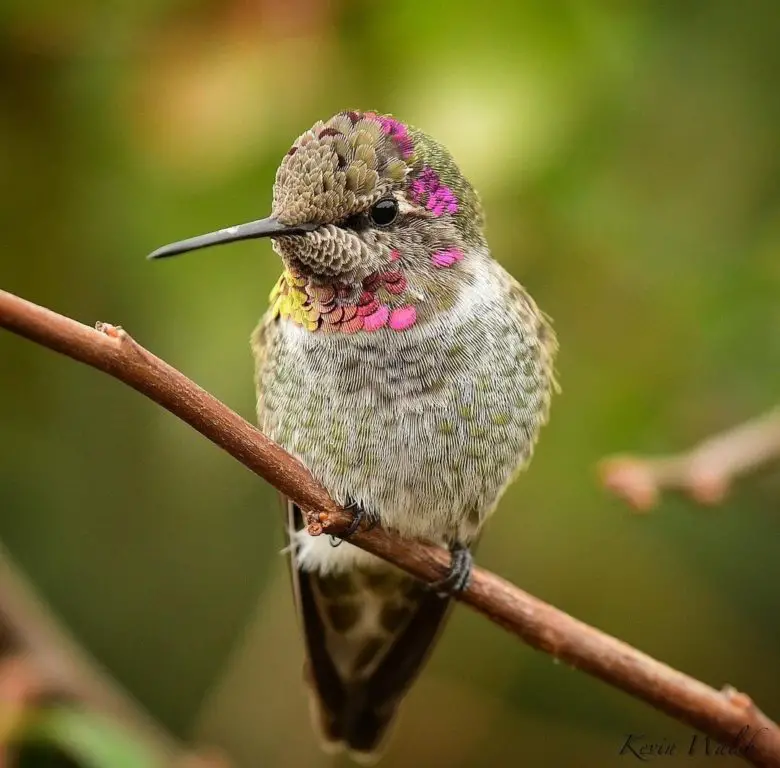
Photo by: Kevin Walsh
Note: This Anna’s hummingbird could be a juvenile in those awkward teenage years or it could be during a molting stage.

Photo by: Kevin Walsh
Note: This baby/juvenile male Anna’s hummingbird is beginning to show his magenta head feathers near his temple along with some faint color starting to show on his gorget. Also, notice the newly white fluffy down feathers near his bottom as well as the nice fat reserves he has accumulated by being fed by his diligent mother.
Female Anna’s hummingbirds are overall not as colorful as the males, appearing pale green in color. Females can also have a gorget, but it is a smaller patch of magenta. Females tend to have a pale white line over each eye that makes them distinctive.

Photo by: rwm_inthewild

Photo by: Kevin Walsh

Photo by: Kevin Walsh

Photo by: Mehta.vishal
See my article: Hummingbird Parents: (Mating to Nesting)
See my article: Baby Hummingbirds: (Egg to Fledgling)
The courtship and dive displays performed by Anna’s hummingbirds are theatrical and entertaining. From the beginning to the end, the full dive display lasts 12 seconds.
See my article: Hummingbird Dance: 5 Interpretive Explanations
Unlike many northern temperate hummingbirds, male Anna’s hummingbirds sing during courtship along with making vibrations with their tail feathers to attract a female.
Anna’s hummingbirds protect their territory with elaborate dives targeted towards predatory birds and even towards people they perceive to be threatening.
Anna’s hummingbirds hybridize, cross breeding readily with Black-chinned and Rufous hummingbirds.
During a capture and release banding operation in Arizona, the oldest living recorded male Anna’s hummingbird was 8 years and 2 months.
See my article: 3 Reasons Why Hummingbirds Are Banded
See pictures of male, female and juvenile Anna’s hummingbirds here…..
Hear sounds of Anna’s hummingbirds here…..
BLACK-CHINNED HUMMINGBIRD – (Archilochus alexandri)
Conservation Status: Least concerned
Kingdom: Animalia
Phylum: Chordata
Class: Aves
Order: Apodiformes
Family: Trochilidae
Genus: Archilochus
Species: A. alexandri
Black-chinned hummingbirds are a migrating species and are considered the hummingbird of the West, therefore, they are a rare visitor to Ohio.
Black-chinned hummingbirds have documented sightings in Ohio on the eBird.org sighting map.
Out of 10,000 hummingbirds seen in Ohio, approximately 11 of them will be Black-chinned hummingbirds.
See the sightings map on eBird.org for where in Ohio Black-chinned hummingbirds have been seen.
Black-chinned hummingbird’s scientific name is in commemoration of Dr. Alexandre, a French doctor who was the first to discover the species in Mexico.
Male Black-chinned hummingbirds are identified by their royal purple gorget, showing a small glimmer of color right near the neckline like a buttoned-up shirt. Since the male purple gorget or throat color is minimal, at times they can appear to look all black. They have metallic green on their backs and flanks with white on their underbelly. Their dark tail is forked and their bill is black. Their size is 3.25 inches to 3.5 inches in length and weigh 2.8-5.6 grams.

Photo by: sony_alpha_male

Photo by: shaunwilseyphotography.com

Photo by: hummingbirdsbysuprise
Female and juvenile Black-chinned hummingbirds have no gorget, but have a dark rounded tail with white tips and beige margins on the dorsal feathers that turn dark black as they mature. Their head and back reflect the dull metallic marbled colors of beige, greens, whites, yellow-green and dark browns, looking similar to the scales found on a snake.
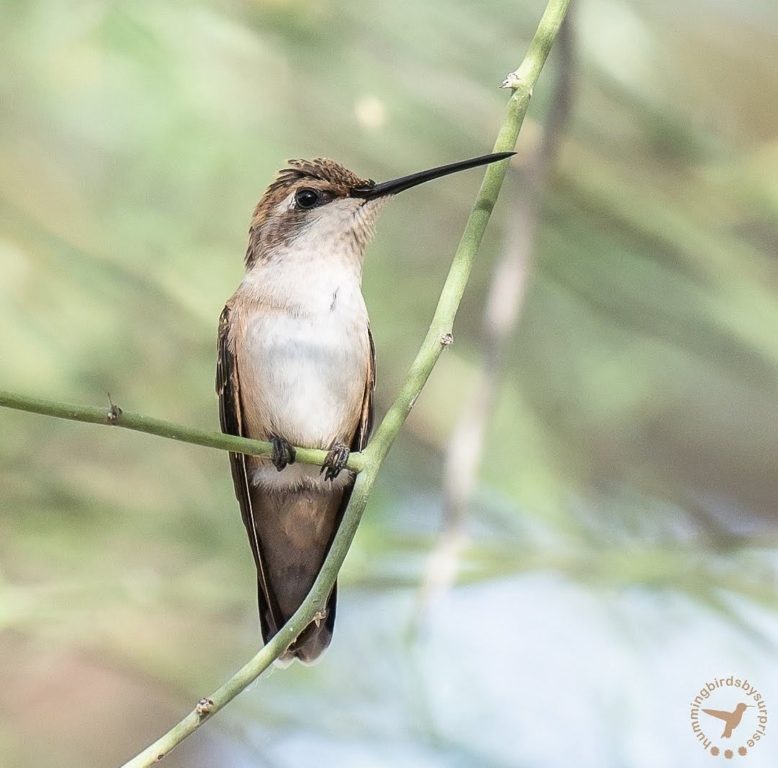
Photo by: hummingbirdsbysuprise
Black-chinned hummingbirds breed east of the Cascade mountain range. They are known to make their nests near larger more active bird nests, reducing the chance of predators around the nest by using a decoy strategy.
Black-chinned hummingbirds have the smallest known genetic material of all living vertebrates or mammals. Because of their small size, they are at risk of being preyed-upon by larger insect-eating birds.
See my article: 10 Common Things That Kill Hummingbirds
While typically a territorial species, if Black-chinned hummingbirds find themselves in an area with a large population of hummingbirds and food sources, their territorial behavior reduces and they will play nice and share.
They hybridize and readily crossbreed with other hummingbird species. Black-chinned hummingbirds can live up to 10 years, which is extremely long in comparison to other birds and animals of similar size.
During a capture and release banding operation in Texas, the oldest living recorded female Black-chinned hummingbird was 11 years and 2 months old.
See my article: 3 Reasons Why Hummingbirds Are Banded
See pictures of male, female and juvenile Black-chinned hummingbirds here…..
Hear sounds of Black-chinned hummingbirds here…..
BROAD-TAILED HUMMINGBIRD – (Selsaphoris platycercus)
Conservation Status: Least concerned
Kingdom: Animalia
Phylum: Chordata
Class: Aves
Order: Apodiformes
Family: Trochilidae
Genus: Selsaphoris
Species: S. platycercus
Broad-tailed hummingbirds have 0 documented sightings in Ohio on the eBird.org sighting map, but one prominent website has the Broad-tailed hummingbird listed as an Ohio hummingbird.
See up-to-date sightings of Broad-tailed hummingbirds in Ohio on eBird.org sighting map.
The Broad-tailed hummingbird usually resides in Mexico and as far south as Guatemala during the winter.
They have a migrant and non-migrant population that begins in the south of Mexico. The ones that migrate north to breed will do so during spring migration and will pass through Arizona, Colorado, Wyoming, Idaho and reach as far north as Montana.
Once the breeding season is complete, Broad-tailed hummingbirds once again depart and begin their southbound fall migration to Mexico to winter and meet up with their non-migrant population.
Male Broad-tailed hummingbirds have an iridescent ruby-red gorget. Both males and females Broad-tailed hummingbirds have green topside and pale underbellies with bright white eye rings and broadly rounded tails. Their size is medium build and ranges from 3.3 inches to 3.8 inches in length and weighs 3.6 grams.

Photo by: shaunwilseyphotography.com

Photo by: shaunwilseyphotography.com
Note: Male Broad-tailed hummingbirds usually have an iridescent ruby-red gorget, however depending on the lighting their gorget can appear dark in color, as shown above.

Photo by: shaunwilseyphotography.com

Photo by: shaunwilseyphotography.com
Note: Preening flight feathers is an important daily routine to maintain hygiene and to keep the feathers flexible, strong, in alignment, and parasite-free.
Female and juvenile Broad-tailed hummingbirds have no gorget, but have green topsides from their head to their tail and pale to beige underbellies with bright white eye rings and broadly rounded tails.
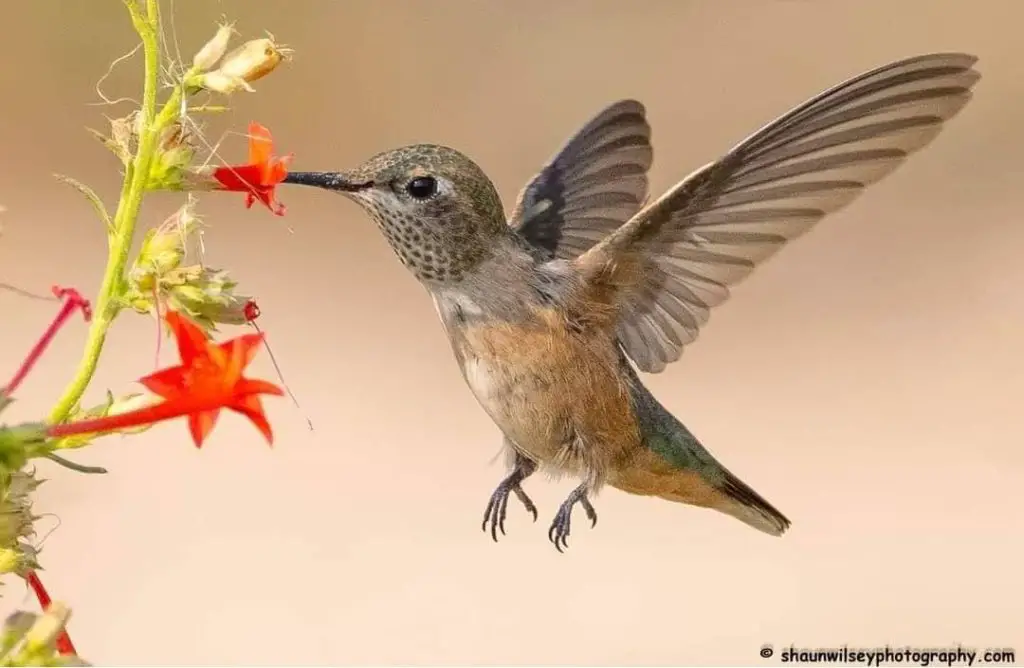
Photo by: shaunwilseyphotography.com

Photo by: shaunwilseyphotography.com
Note: Hummingbirds beat their wings 80 beats per second. While hovering, the wings move back and forth forming a figure eight or infinity symbol. This powerful movement creates a fanning effect as noticed by the ruffling feathers on both sides of her lower back.

Photo by: shaunwilseyphotography.com
Note: The thick blanket of pollen on its bill and throat. This juvenile Broad-tailed hummingbird has been busy pollinating and drinking nectar from flowers to sustain its high metabolism.

Photo by: shaunwilseyphotography.com

Photo by: shaunwilseyphotography.com
Note: The newly white fluffy down feathers on this baby/juvenile Broad-tailed hummingbird’s bottom. Also, notice the nice fat reserves they have accumulated by being fed by their diligent mother which will sustain them through adolescence.
The Broad-tailed hummingbird favors habitats in the understory of mature forest woodlands such as pine and oak groves. They chose to nest on the branches of trees and have been known to return to the same nesting ground each year, roughly 70% of the time.
Their breeding time coincides with the peak time of flowering native plants for maximum food resource availability. Their favorite nectar producing flower plants include: Red Columbine, Indian Paintbrush, Sage varieties, Currants and Scarlet Mint.
They are promiscuous and do not form any kind of a pair bond between male and female birds and again the female raises the young alone.
The Broad-tailed hummingbird has suffered a decline in population since the 1990s, but presently, its population is stable, and it has been shown to have adapted to human habitat encroachment.
During a capture and release banding operation in Colorado, the oldest living recorded female Broad-tailed hummingbird was 12 years and 2 months.
See my article: 3 Reasons Why Hummingbirds Are Banded
See pictures of male, female, and juvenile Broad-tailed hummingbirds here…..
Hear sounds of Broad-tailed hummingbirds here…..
CALLIOPE HUMMINGBIRD – (Selasphorus calliope)
Conservation Status: Least concerned
Kingdom: Animalia
Phylum: Chordata
Class: Aves
Order: Apodiformes
Family: Trochilidae
Genus: Selasphorus
Species: S. calliope
Calliope hummingbirds are a migrating species and are a rare visitor to Ohio since they are seen mainly in the Western United States.
Calliope hummingbirds have documented sightings in Ohio on the eBird.org sighting map. Out of 10,000 hummingbirds seen in Ohio, approximately 18 will be Calliope hummingbirds.
See the sightings map on eBird.org for where in Ohio Calliope hummingbirds have been seen.
Calliope hummingbirds are the smallest long-distance migratory bird in the world. Their migratory patterns mimic Rufous hummingbirds with spring migration. During northbound spring migration they pass through the Pacific Flyways.
On their southbound journey in the fall, they pass through the Pacific and Rocky Mountain Flyways towards their wintering destination in Mexico.
Calliope hummingbirds are named after a Greek mythological muse, who represented poetry and eloquence. Calliope means “beautiful voice” in ancient Greek.
Male Calliope hummingbirds are easily identified by their iridescent purple crown and long striking spaced outline row of feathers that project down the sides of their throat. Like many hummingbirds, the backs are metallic green and these birds measure 3 inches in length and weigh 2-3 grams.

Photo by: sony_alpha_male

Photo by: sony_alpha_male
Note: His bright throat feathers are slowly coming in.
Female Calliope hummingbirds have gray-green crowns and buff-colored flanks which are the underbelly or wing of a bird. Females sport dark tails with white tips.

Photo by: sony_alpha_male
Like many hummingbirds, Calliopes communicate not just by their song, but also by manipulating their feathers during flight to make different buzzing noises that act as a form of language and communication.
When a female is quietly perched, the male will passionately fly back and forth and engage in a “U” shaped courtship display to gain her attention. During his presentation, the male hummingbird will produce a vocal serenade while swinging his body from side to side in front of the female.
See my article: Hummingbird Dance: 5 Interpretive Explanations…..
Male Calliope hummingbirds establish a breeding territory and mate with every available female hummingbird that accepts his courtship.
During nest construction, the female Calliope chooses tops of pine cones as her building site. She will also dismantle nests from previous seasons and recycle them in her new nest along with stealing materials from the nests of other birds in order to construct her own.
Therefore, female Calliopes are often chased and attacked by larger and more aggressive hummingbirds such as Allen’s and Rufous hummingbirds. To avoid these attacks, the Calliope maintains a relatively low profile in comparison to other species.
Because Calliope hummingbirds have a more restricted wintering range than most hummingbirds, they are particularly vulnerable to habitat loss and natural disasters, such as climate change and wildfires.
During a capture and release banding operation in Idaho, the oldest living recorded female Calliope hummingbird was 8 years and 11 months old when she was captured twice, once in 2007 and again in 2014.
See my article: 3 Reasons Why Hummingbirds Are Banded
See pictures of male, female and juvenile Calliope hummingbirds here…..
Hear sounds of Calliope hummingbirds here…..
MEXICAN VIOLETEAR HUMMINGBIRD – (Colibri thalassinus)
Conservation Status: Least concerned
Kingdom: Animalia
Phylum: Chordata
Class: Aves
Order: Apodiformes
Family: Trochilidae
Genus: Colibri
Species: C. thalassinus
The Mexican violetear (Violet-ear) hummingbird or the Green-violetear gets its name from the Latin word thalassinus meaning “color of the sea”. They migrate from the tropical regions of Central America and are considered extremely rare when sited in Ohio.
If a hummingbird enthusiast is fortunate enough to see a Mexican violetear hummingbird in Ohio, consider it as lucky as winning the jackpot in Las Vegas.
The Mexican violetear hummingbird has documented sightings in Ohio on the eBird.org sighting map.
Out of 100,000 hummingbirds seen in Ohio, only 1 will likely be a Mexican Violetear hummingbird.
See the sightings map on eBird.org for where in Ohio the Mexican violetear hummingbird has been seen.
Male Mexican violetear hummingbirds are iridescent green in color with a show of bright violet ear patches on each side of their neck (hence the name “violet-ears”). The tail of this hummingbird is metallic blue-green with bronze central tail feathers that feature a black band underneath. Their size ranges from 3.8 inches to 4.7 inches in length and they weigh 5-6 grams.
These species of hummingbirds are found on the edge of cloud forests from Mexico to Nicaragua, where they enjoy a high level of tropical humidity in their environment. This dark hummingbird is commonly seen in forest clearings and edges.
Mexican violetear hummingbirds are somewhat nomadic. Scientists do not know much about their migration patterns as they have not been well-studied. But of the data that has been collected, the Mexican violetear is typically found in central Mexico, Central America, and northern South America.
While mostly a permanent resident throughout its normal range, some individual Mexican violetear hummingbirds have strayed and wandered as far north as Wisconsin, Michigan, and even Canada.
Like many other kinds of hummingbirds, the Mexican violetear hummingbird is a solitary nester. They forage for nectar and insects alone rather than in a flock, but groups of these hummingbirds can be seen around flowering trees, such as the coffee-shade Inga tree.
See pictures and hear sounds of Mexican violet-ear hummingbirds here…..
Happy Hummingbird Watching!
Backyard Visitors participates in affiliate programs which compensate us for referring traffic.
